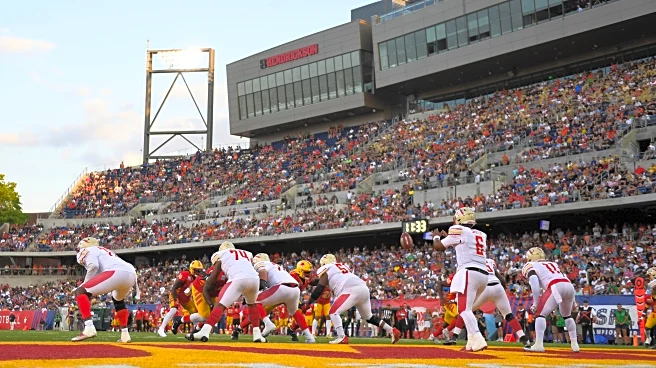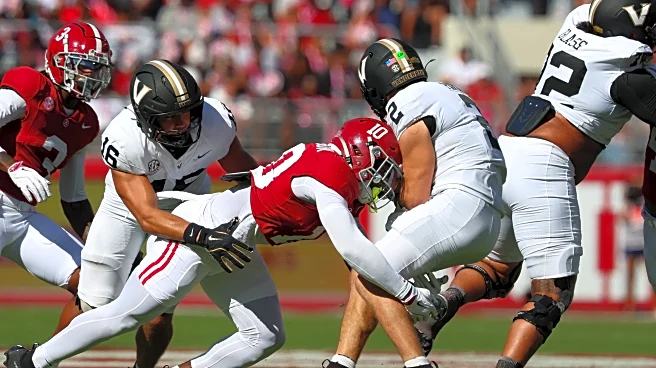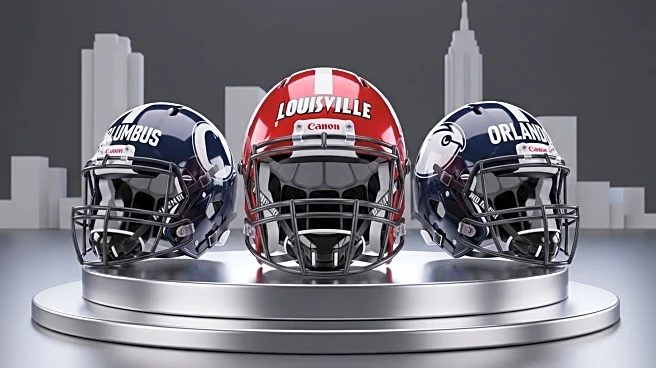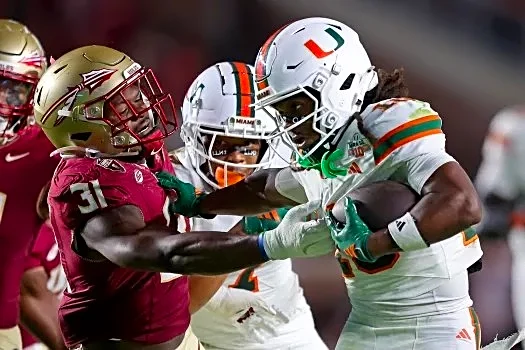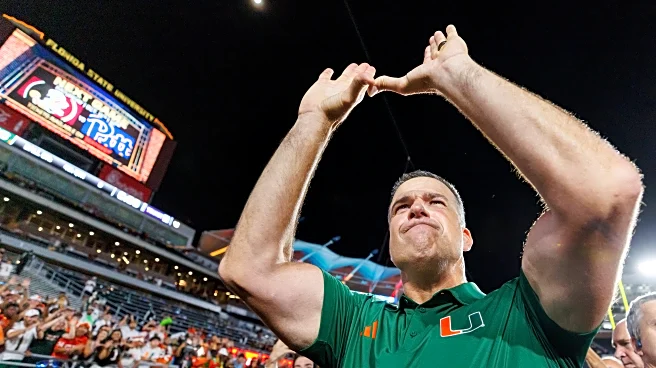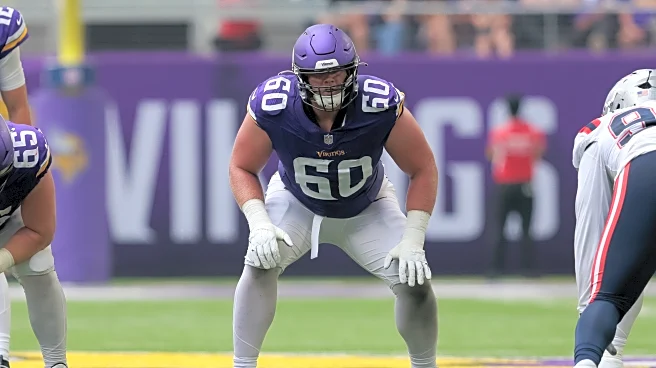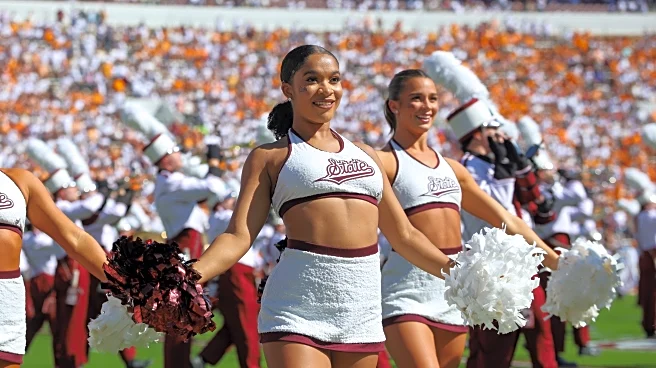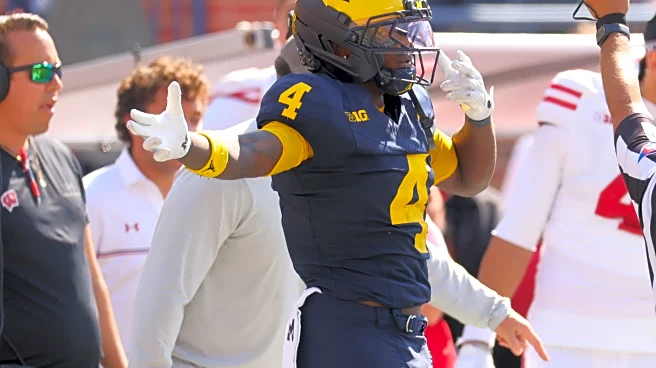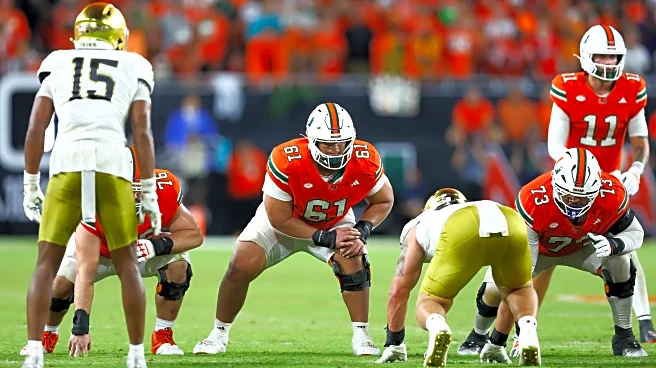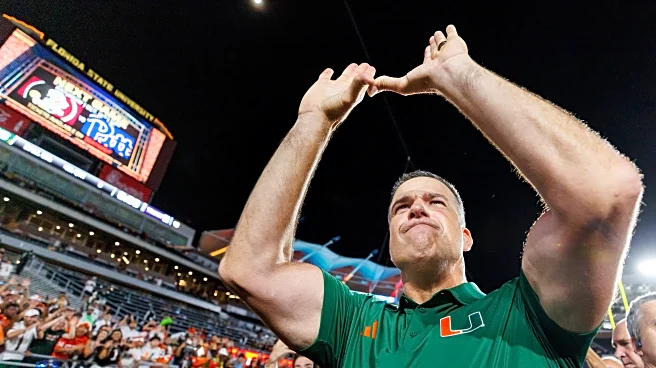The United Football League (UFL) has its place in the pro football universe. It is strictly a developmental league that enables players to remain in the game and get some experience. It is home to those
who aren’t good enough for the NFL or Canadian Football League, and their practice squads.
RELATED: NEW YORK CITY FC “THE CUBE”
And both leagues have many former UFL players on their current rosters. So, the league does allow these guys the opportunity to continue their dream.
However, the UFL is not a farm system. Pro baseball has six levels of teams that feed their parent clubs. Many players come straight out of high school to compete and hopefully elevate to the next level so that one day they can become a Major Leaguer.
The NFL has only one system in place to train young players. It is called college football.
The UFL has announced that they are relocating three of its member teams for 2026. Russ Brandon, President & CEO of the UFL, stated in an email:
“As part of this process, we conducted a thorough review of all markets and venues. After careful consideration, we’ve made the difficult decision to depart from the Memphis, Michigan, and San Antonio markets. Unfortunately, the stadium options currently available in these areas do not align with our new vision. As we look ahead to potential expansion in 2028, we remain hopeful that the right venues will become available in these markets so we can return and once again bring UFL football to these communities.”
The UFL came about as a merger between the XFL and the USFL in 2024. Both leagues were eight-team entities, and the new league kept four clubs from each association. Some teams play their home games in huge venues with huge leases, while others have found smaller stadiums like those built to house MLS clubs.
Since the 1940s, there have been several leagues that have sprouted up to compete with the NFL such as the All-America Football Conference (1946-1949), American Football League5 (1960-1969), World Football League (1974-1975), United States Football League (1983-1986), Regional Football League (1999), XFL (2001), United Football League2 (2009-2012), Alliance of American Football (2019), XFL2 (2020-2023), USFL2 (2022-2023), and numerous indoor leagues.

The majority of these outdoor leagues had individual owners with each club. However, some organizations were established with league-owned teams, such as the AAF, XFL, XFL2, and USFL2. This means that the league itself owns and controls all aspects of every team involved, including rosters.
This new UFL is set up the same way and plays a spring schedule. They own all of their member teams.
Since the merger, the teams have remained in the same cities: San Antonio, Texas; Birmingham, Alabama; Memphis, Tennessee; Houston, Texas; Detroit, Michigan; Washington, DC; Arlington/Dallas, Texas; and St. Louis, Missouri.
Half of the league is located in cities that have existing NFL clubs. The other half have had a pro football team at some point in the past with other leagues. St. Louis has had three former NFL teams: the Gunners, Cardinals, and Rams.
The Memphis Southmen of the WFL drew really well and were one of the league’s best teams for their two-year duration. The Birmingham Americans of the same league also had very good attendance, as did the Birmingham Stallions of the first version of the USFL in 1984, with an average of 36,865. The San Antonio Riders were one of the leaders in attendance in the World League of American Football in the 1990s.
During the 2025 season, only one UFL team had decent attendance: the St. Louis Battlehawks. They played at the Dome at America’s Center, which has a capacity of 67,277. They averaged 29,537 fans this past spring and led the league in attendance for the second year in a row.
It has been said that when the NFL does another round of expansion, St. Louis will be at the top of the list. The NFL obviously looks at the UFL to see if any of its cities are ripe for an expansion team in the near future. So far, only St. Louis is showing the established league that they miss the professional game and are ready for another franchise to call their city home.

This past spring, the average attendance per UFL game was as follows: St. Louis – 29,537; DC – 13,026; Michigan (Detroit) – 11,681; San Antonio – 11,105; Arlington/Dallas – 9,763; Birmingham – 8,800; Houston – 5,752; and Memphis – 3,992.
But the number of tickets sold is only one part of having a pro football team in a city. There is also the matter of the stadium lease, and what the seating capacity is, plus whether the seating capacity can fill the needs of the team as the popularity of the team increases.
Take Detroit, for example. The Michigan Panthers were paying $400,000 a game to lease Ford Field, home of the NFL Detroit Lions.
The UFL is known for having cheap ticket prices, around 20 bucks a ticket. This harkens back to the early days in the NFL when a father could bring his wife and two children, pay a nominal parking fee, eat hot dogs, nachos, and popcorn, drink a few beers and some Cokes, sit where everyone could see the game action, and not spend half of his weekly paycheck. Or four adult friends could go see a game and not fork over $1,000 for four seats, food, and adult beverages.
Not to mention, there aren’t any PSLs to worry about in the UFL.
UFL players who signed with the Cardinals this year included OL Dohnovan West, CB Keni-H Lovely, CB Steven Gilmore, and DL Kyon Barrs.
What is unique about the UFL is its practice and living structure. Players and coaches don’t live in the city they represent.
None of the Memphis Showboats live in the Memphis area. No player for the league champion DC Defenders has an apartment in or around Central Maryland.

All players and coaches live in the Arlington and Dallas area. They practice in the Arlington and Dallas area. The day before a game, teams fly out to their next game. Sometimes, both teams are on the same airplane. They all stay at the same hotel in whatever city the game is scheduled. Afterwards, they get on a chartered bus and head to the airport, and fly back to Arlington.
The only time this becomes different is in games played in Arlington. Then all week, teams have their own practice fields in the Arlington/Dallas area, and stay locally.
Every UFL player signs a one-year deal, and in 2026, their pay increases from $5,500 to $6,400 a game. Other benefits include $150 a week toward 401K contributions, $400 per week housing stipend, and $55-a-day per diem stipend during travel days.
Attendance and TV issues
The UFL has talked about expansion plans. After their first season, it was discussed to have two more teams in the fray in 2025 that were once an XFL and a USFL club. Then perhaps another two going into 2026, and so on until all former XFL and USFL teams were back in the fold.
But the issue in their maiden year was that they didn’t have the gate to sustain the teams they already had. Few teams were drawing well. So calmer heads decided to build what they had, and table expansion.
And besides, the idea of getting back all of those other cities just might not be the right move either. For one, both former leagues had a club in Houston. A lot of the former teams did not draw well, so that was tabled. Perhaps the more prudent move would be to go into a region that was a good football town and yet wasn’t a huge metropolitan area. Instead of going back to Philadelphia, why not look at Austin (TX), Salt Lake City (UT), Shreveport (LA), or Norfolk (VA) instead?
The original USFL in the mid-1980s went after the NFL and had most of its teams in the same places and stadiums as their NFL counterparts. They wanted to be on the same plateau as the established league, attracting 70,000+ each weekend, instead of being satisfied with 25,000 crowds.
But the UFL has a vision that 20,000-30,000 folks a game for every member club is exactly what they want. The problem is, after two complete seasons, only one team out of eight is drawing those numbers.

As far as television numbers are concerned, the UFL dropped viewership by 19% this past season. And it’s not like the league is on secondary networks such as ESPN2 or Prime, where not every household has access to those networks, so viewership was limited. The UFL was broadcast on FOX, which also has an NFL contract and used their same tactics, technology, equipment, and producers to stage each game.
The issue with the UFL was, simply put, that the public did not show up for live games. Maybe games were shown locally on the tube. Maybe the weather didn’t cooperate on game days. Maybe certain teams were not good and lost a lot of games. Maybe the play was sloppy. Maybe there weren’t enough named “stars” for people to care. Or any star players for that matter.
The point is, attendance in the UFL has been horrible.
Each game, the league has to pay for the stadium rental, all of the game officials, salaries for the head coach and his assistant coaches, salaries for each player, hotel rentals on gameday for two full teams plus front office personnel, flight tickets for each player, coach, trainers and personnel people for each team, seven days of meals, local doctors hired for each game, equipment, Gatorade, and game balls, hotel bills for every player and coach back in the Arlington area, plus practice field rentals.
That is each and every week.
New cities for 2026
Now, the UFL is tired and frustrated with franchises that don’t draw well and stadium leases that aren’t feasible. So, the league has decided to relocate three teams to new cities for the 2026 season. The thought process seems to be, if you can’t show up for games where ticket prices are dirt cheap, and your team is in the playoffs, then we will find a city that wants a pro football franchise instead.
The league was patient. It waited long enough. Now, it is time to move on to greener playing fields.
On Friday, October 3rd, the UFL sent out an email stating that their league had decided to relocate three teams: the San Antonio Brahmas, Memphis Showboats, and Michigan Panthers.
Brandon continued:
“The United Football League is committed to delivering the most accessible and innovative football experience every spring. This offseason, in partnership with our new ownership group, we’ve refreshed our vision for the league with a focus on playing in more intimate venues that elevate the fan experience and bring unmatched energy to game day.”
On the surface, moving Michigan and San Antonio is a head-scratcher, as they were ranked third and fourth, respectively, in attendance. But stadium issues led to their demise. Michigan had an average of 11,681 patrons per game while San An had 11,105.
St. Louis led the league both years in attendance with an average of 29,537 fans in 2025 and 34,365 in 2024.
Several UFL teams had stadium lease problems.
The Houston Roughnecks played their home games at Space City Financial Stadium, which seats 39,700. The Roughnecks averaged 5,752 per game this past year. Going forward, the league was able to work out a lease with Shell Energy Stadium, home of the MLS Houston Dynamo FC, with a seating capacity of 20,656. Not only did the venue become smaller, but so did the lease, which kept the team in the fourth-largest market in the United States.
The problem with San Antonio is that the UFL team wants venues that aren’t as large. The Alamodome seats 64,000. This past season, the Brahmas only played four home games because the dome’s capacity was just too big. On game days, with just around 12,000 in attendance, it appeared to be a cavern. There wasn’t a feasible alternative in the city, so the franchise is moving.
The Michigan Panthers played in the league championship game and lost 58-34. Now, the City of Detroit is losing its UFL club. Their home field was Ford Field, which seats 70,000 for football. Just over 11,000 fans in a stadium that large just wasn’t cutting it. Plus, the lease was enormous, costing $400,000 for each home game. The UFL is now relocating the team.
And finally, the Memphis Showboats. They played at the Simmons Bank Liberty Stadium, built in 1965 with a seating capacity of 50,000. This is where the annual Liberty Bowl is played and is also the home of the Memphis Tigers college team. The Showboats went 2-8-0 this season and were never competitive. They had the same record in 2024.
RELATED: WHAT’S NEXT FOR THE SHOWBOATS?
The Memphis Southmen of the WFL were a very good team, going 17-3-0 in their first season and 7-4-0 in the following year, which ended after 11 games played. Their first two home games, they had over 30,000 per contest, then averaged 20,209 fans per game. That was back in 1974-1975.
After the WFL folded, the City of Memphis petitioned the NFL to admit the Southmen, but was turned down. Today, perhaps people don’t think the NFL will notice them because fans simply weren’t attending home games. They were dead last in attendance in 2024 as well, with an average crowd of 6,893. It is quite obvious why the UFL is pulling up stakes and getting the hell outta Dodge.
It’s rough when the fans don’t even care enough to show up.
So, what’s next? Where are these three teams playing next year?
According to sources, Columbus, Ohio, is a lock. There are two MLS stadiums in Columbus, both owned by Haslam Sports. Of course, Jimmy and Dee Haslam are owners of the Cleveland Browns.
They also own the Columbus Crew of the MLS. The Crew plays its home games at Lower.com Field, which is a soccer-specific stadium with a seating capacity of 20,371 that opened in 2021. But these sources are stating that the UFL team will use the Crew’s former venue instead: Historic Crew Stadium. This arena holds 22,555 patrons and was built in 1998.

Historic Crew Stadium is the second venue built in the United States just for soccer matches. The other was constructed in Pennsylvania in 1913. Historic was the first stadium built specifically for MLS games, which began the slew of soccer-inspired stadiums across North America.
Currently, Historic is used for Crew practices and Columbus Crew 2 home games, which competes in the “MLS Next Pro league,” the third division of American soccer.
This means that one of these UFL clubs will become tied to the Haslams in a stadium lease agreement.
Other cities that appear to have the most interest from the UFL include Louisville, Kentucky, Orlando, Florida, Tampa, Florida, Boise, Idaho, and Tulsa, Oklahoma.
The league has announced that in 2028 it will expand. Of course, three cities from the expansion list will be scratched off this year. What appears odd is how the league has avoided the West Coast whatsoever. Cities such as Portland, Sacramento, San Diego, and Seattle aren’t being discussed as possible locations. Which is weird in the fact that players are being flown out each week, so what does it matter if they fly east or west? Perhaps it’s deliberate with time zones.
Further details about the UFL’s new markets and venues will be shared in an announcement later this week.

